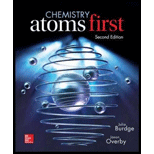
(a)
Interpretation:
The respective names of the compounds has to be given.
Concept Introduction:
In the formula of the compound, the sum of the charge of cation and anion must be equal to zero. The ration of cation and anion to be known in order to arrive the formula of a compound.
Rules for Nomenclature of ionic compounds:
- The name of the cation is followed by the name of the anion.
(b)
Interpretation:
The respective names of the compounds has to be given.
Concept Introduction:
In the formula of the compound, the sum of the charge of cation and anion must be equal to zero. The ration of cation and anion to be known in order to arrive the formula of a compound.
Rules for Nomenclature of ionic compounds:
- The name of the cation is followed by the name of the anion.
(c)
Interpretation:
The respective names of the compounds has to be given.
Concept Introduction:
In the formula of the compound, the sum of the charge of cation and anion must be equal to zero. The ration of cation and anion to be known in order to arrive the formula of a compound.
Rules for Nomenclature of ionic compounds:
- The name of the cation is followed by the name of the anion.
Want to see the full answer?
Check out a sample textbook solution
Chapter 5 Solutions
Chemistry: Atoms First
- Write formulas for ionic compounds. (a) What is the formula of the ionic compound expected to form between the elements sodium and fluorine? (b) What is the formula of the compound formed between the ions Co²+ and SO₂²? (c) What ions make up the ionic compound Zn(CN)₂? Cation formula Anion formulaarrow_forward(a) What is the formula of carbon disulfi de? (b) What is the name of PCl5? (c) Give the name and formula of the compound whose molecules each consist of two N atoms and four O atoms.arrow_forwardName the following binary ionic compounds. (a) MgF2 (b) Bal2 (c) FeCl2arrow_forward
- Predict whether the following compounds are ionic or molecular:(a) KI, the compound used as a source of iodine in table salt(b) H2O2, the bleach and disinfectant hydrogen peroxide(c) CHCl3, the anesthetic chloroform(d) Li2CO3, a source of lithium in antidepressantsarrow_forwardAnswer true or false. (a) The name of a binary ionic compound consists of the name of the positive ion followed by the name of the negative ion. (b) In naming binary ionic compounds, it is necessary to state the number of each ion present in the compound. (c) The formula of aluminum oxide is Al2 O3 . (d) Both copper(II) oxide and cupric oxide are acceptable names for CuO. (e) The systematic name for Fe2 O3 is iron(II) oxide. (f) The systematic name for FeCO3 is iron carbonate. (g) The systematic name for NaH2PO4 is sodium di- hydrogen phosphate. (h) The systematic name for K2HPO4 is dipotassium hydrogen phosphate. (i) The systematic name for Na2O is sodium oxide. (j) The systematic name for PCl3 is potassium chloride. (k) The formula of ammonium carbonate is NH4CO3. 39. (a) A covalent bond is formed between two atoms whose difference in electronegativity is less than 1.9. (b) If the difference in electronegativity between two atoms is zero (they have identical electronegativ- ities),…arrow_forwardBefore the use of systematic names, many compounds had common names. Give the systematic name for each of the following: (a) Blue vitriol, CuSO4*5H2O (b) Slaked lime, Ca(OH)2 (c) Oil of vitriol, H2SO4 (d) Washing soda, Na2CO3 (e) Muriatic acid, HCl (f) Epsom salt, MgSO4*7H2O (g) Chalk, CaCO3 (h) Dry ice, CO2 (i) Baking soda, NaHCO3 (j) Lye, NaOHarrow_forward
- Which of the following pairs react to form ioniccom-pounds: (a) Cl and Br; (b) Na and Br; (c) P and Se; (d) H and Ba?.arrow_forwardMany chemical names are similar at first glance. Give the for-mulas of the species in each set: (a) ammonium ion and ammo-nia; (b) magnesium sulfide, magnesium sulfite, and magnesiumsulfate; (c) hydrochloric acid, chloric acid, and chlorous acid; (d) cuprous bromide and cupric bromidearrow_forwardName the following binary molecular compounds: (a) ClO2 and (b) CBr4.arrow_forward
- Give the formulas of the compounds in each set: (a) lead(II)oxide and lead(IV) oxide; (b) lithium nitride, lithium nitrite, and lithium nitrate; (c) strontium hydride and strontium hydroxide;(d) magnesium oxide and manganese(II) oxide.arrow_forwardMany chemical names are similar at first glance. Give the formulas of the species in each set: (a) Ammonium ion and ammonia (b) Magnesium sulfide, magnesium sulfite, and magnesium sulfate (c) Hydrochloric acid, chloric acid, and chlorous acid (d) Cuprous bromide and cupric bromidearrow_forwardWhich of these compounds is named correctly? (A) MnO2 = manganese(II) oxide (B) Cu2S = copper(I) sulfide (C) Na3PO4 = trisodium phosphate (D) CaF2 = calcium(II) fluoridearrow_forward
 Organic ChemistryChemistryISBN:9781305580350Author:William H. Brown, Brent L. Iverson, Eric Anslyn, Christopher S. FootePublisher:Cengage Learning
Organic ChemistryChemistryISBN:9781305580350Author:William H. Brown, Brent L. Iverson, Eric Anslyn, Christopher S. FootePublisher:Cengage Learning Introduction to General, Organic and BiochemistryChemistryISBN:9781285869759Author:Frederick A. Bettelheim, William H. Brown, Mary K. Campbell, Shawn O. Farrell, Omar TorresPublisher:Cengage Learning
Introduction to General, Organic and BiochemistryChemistryISBN:9781285869759Author:Frederick A. Bettelheim, William H. Brown, Mary K. Campbell, Shawn O. Farrell, Omar TorresPublisher:Cengage Learning

